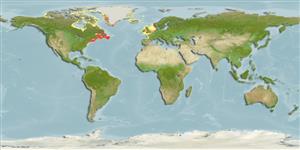Environment: milieu / climate zone / depth range / distribution range
Ecologia
marino demersale; distribuzione batimetrica 0 - 108 m (Ref. 58426). Polar; 84°N - 36°N, 127°W - 6°E (Ref. 57357)
North Atlantic: Greenland to North Carolina. Also in the northeast Atlantic (Ref. 7251).
Size / Peso / Age
Maturity: Lm ? range ? - ? cm
Max length : 25.0 cm TL maschio/sesso non determinato; (Ref. 7251)
Short description
Chiavi di identificazione | Morfologia | Morfometria
Spine dorsali (totale) : 0; Raggi dorsali molli (totale) : 56 - 67; Spine anali: 0; Raggi anali molli: 28 - 35; Vertebre: 68 - 76. Number of lateral plicae 124-147, with a mean of 132.1.
Occurs farther offshore in salinities of 30-36 ppt. Minimum depth reported taken from Ref. 57178. Benthic. Feeds on crustaceans and worms (Ref. 58426); mainly on copepod, Calanus finmarchicus (Ref. 5951).
Life cycle and mating behavior
Maturities | Riproduzione | Spawnings | Egg(s) | Fecundities | Larve
Robins, C.R. and G.C. Ray, 1986. A field guide to Atlantic coast fishes of North America. Houghton Mifflin Company, Boston, U.S.A. 354 p. (Ref. 7251)
IUCN Red List Status (Ref. 130435)
Threat to humans
Harmless
Human uses
Pesca: di potenziale interesse
Strumenti
Special reports
Download XML
Fonti Internet
Estimates based on models
Preferred temperature (Ref.
123201): 1.2 - 12.8, mean 7.2 °C (based on 218 cells).
Phylogenetic diversity index (Ref.
82804): PD
50 = 0.5156 [Uniqueness, from 0.5 = low to 2.0 = high].
Bayesian length-weight: a=0.00204 (0.00115 - 0.00362), b=3.06 (2.91 - 3.21), in cm total length, based on LWR estimates for this species & Genus-body shape (Ref.
93245).
Trophic level (Ref.
69278): 3.2 ±0.1 se; based on diet studies.
Resilienza (Ref.
120179): Medio, tempo minimo di raddoppiamento della popolazione 1.4 - 4.4 anni (K=0.33-0.38; tmax=9).
Fishing Vulnerability (Ref.
59153): Low to moderate vulnerability (33 of 100).
